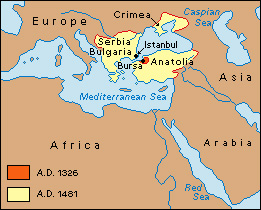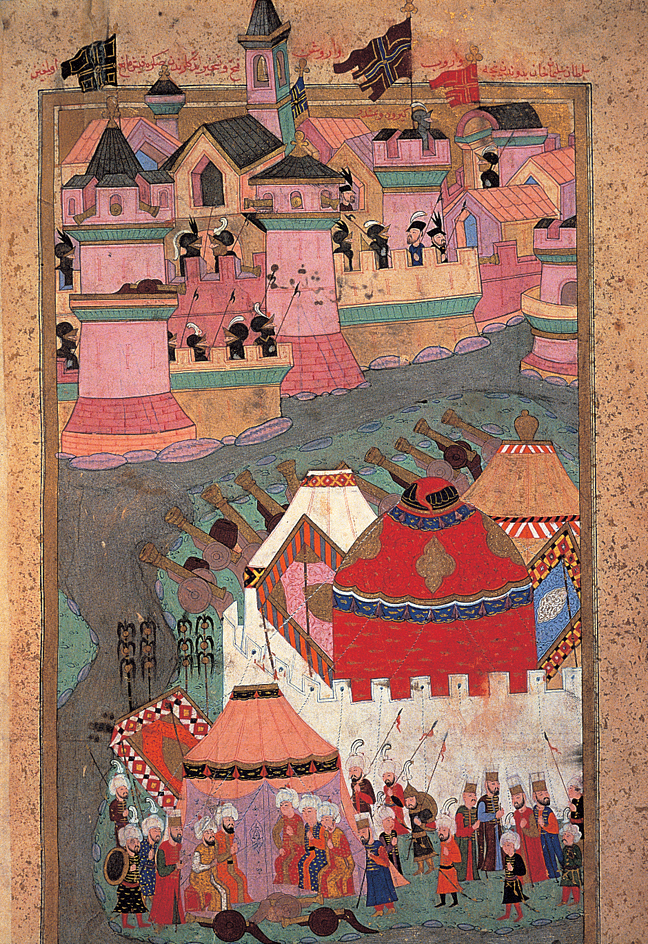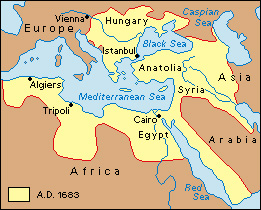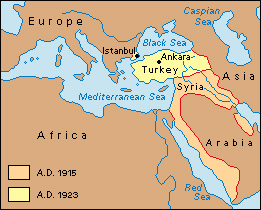Ottoman Empire was one of the most powerful empires in the world during the 1500’s and 1600’s. At its height, it controlled what is now Turkey and parts of northern Africa, southwestern Asia, and southeastern Europe. The empire began about 1300 and lasted until 1922. The Ottomans were nomadic Turkish tribes that had migrated to the Middle East from central Asia. The term Ottoman comes from Osman, also called Othman or Uthman, the founder and first sultan (ruler) of the empire.
Before the arrival of the Ottomans, the Byzantine Empire had occupied parts of Asia Minor (now part of Turkey) and southeastern Europe for almost 1,000 years. That empire ended in 1453, when the Ottomans conquered the Byzantine capital of Constantinople (now Istanbul). They made the city their capital. By the mid-1500’s, the Ottomans ruled Asia Minor, the Balkans, and parts of northern Africa and present-day Iran, Saudi Arabia, and Syria. The Ottomans were Muslims, and they spread their religion, Islam, throughout the empire.
The Ottoman Empire slowly declined only after 1700, when it was faced with the emerging powers of Europe. When World War I began in 1914, the Ottoman Empire consisted of only Asia Minor, parts of southwestern Asia, and part of the Balkans. The Ottomans were defeated in the war, and the empire came to an end in 1922.
Ways of life
People
of the Ottoman Empire, in addition to Turks, included many Arabs, Armenians, Greeks, and Slavs. The official language was Ottoman Turkish. The empire had two classes of people. The ruling class paid no taxes and included the imperial family, owners of large estates, and military and religious leaders. The rest of the people were peasants and craftworkers who did pay taxes. The sultan was responsible for protecting them against invasion and abuse by his ruling class. The profession and status of most individuals could be determined by the color and style of clothing and the size of the turban or other headdress they wore.
Almost all the women of the Ottoman Empire lived restricted lives. Islamic law permitted a man to have as many as four wives at a time. Muslim women lived most of their lives in seclusion, usually in a separate section of a household. This section was called a harem (see Harem). Some women gained power within their harem and had great influence over their husbands and sons. Muslim women also were required to wear veils in public. Many similar restrictions affected non-Muslim women as well.
Most Muslims strictly followed the rules of Islam as set down in their holy book, the Qur’ān (see Islam (Teachings and practices)). However, the Ottomans allowed all religious groups to practice their own faiths. Christians and Jews made up the largest non-Muslim groups. Each religious group, including the Muslims, formed a millet (nation), whose leader represented its members before the government.
Cultural life.
Neighborhood mosques (Muslim houses of worship) served as both religious and social centers for Muslims. Other millets had their own religious ceremonies and social events. The Ottomans adopted many styles of Byzantine and Persian art and literature. Major Ottoman contributions came in the fields of architecture, carpet weaving, and tile making.
Ottoman education emphasized religious studies. Beginning in the 1300’s, boys attended schools in mosques. The best students went on to high schools called medreses. Girls began to go to elementary school in the mid-1800’s. Secular (nonreligious) education at the high school and university levels began about the same time.
Economy.
Most of the people of the Ottoman Empire worked as farmers. Grain was grown in fertile areas of Egypt, Syria, and lands surrounding the Black Sea. Craftworkers and merchants practiced their trade in the cities and towns.
The Ottoman Empire gained great wealth through trade. Some of the busiest trade routes between Asia and Europe ran through the empire. Merchandise offered in the markets of Ottoman cities included Chinese porcelains, European woolens, Persian silks, and spices from Asia.
Government.
The Ottoman sultans made all important governmental decisions for the empire. The sultans appointed officials to collect taxes and to keep peace within the empire. The powers of the sultans were limited in some ways. For example, the rulers needed the support of the army to maintain their position. In addition, new laws were subject to the approval of the empire’s chief religious judge, the grand mufti, before they could take effect.
Until the 1630’s, the oldest or favorite son succeeded to the throne upon the death of a sultan. After the 1630’s, it became common for the successor to be the oldest surviving male member of the family. Some sultans removed threats to their throne by murdering potential rivals or confining princes to the royal palace.
History
The beginning of the empire.
The Turkish tribes led by Osman began to expand their small territory in the northwest corner of Anatolia (now Turkey) during the late 1200’s. In 1326, the tribes captured the city of Bursa, which had been part of the Byzantine Empire. In the late 1300’s, the Ottomans formed a group of highly trained soldiers called Janissaries (see Janissaries).

Expansion and decline.
By the mid-1400’s, the Ottomans had conquered almost the entire Byzantine Empire. Ottoman troops, led by Sultan Mehmet II, succeeded in capturing the capital city of Constantinople in 1453.
Under Mehmet II (also spelled Mehmed II), the Ottomans also conquered much of southeastern Europe and territory near the Black Sea. They took over Syria in 1516 and Egypt in 1517. The empire reached its peak of power and wealth under Sultan Süleyman I, who ruled from 1520 to 1566. His armies conquered Hungary, northern Africa, and territory on the east coast of the Red Sea down to what is now Yemen.

In 1571, naval forces from Spain, Venice, and the Papal States of Italy almost destroyed the Ottoman fleet in the Battle of Lepanto. But the navy was rebuilt, and the empire continued to grow. In 1683, Austrian and Polish troops turned back an Ottoman attack on Vienna, Austria. This defeat ended the empire’s territorial expansion.

During the next 200 years, many nations won independence from Ottoman rule. Government corruption, oppressive taxation, inflation, and weak sultans also contributed to the decline of the empire.
The empire ends.
In 1908, a group of Ottoman military officers called the Young Turks forced Sultan Abdulhamit II to restore the empire’s constitution, which guaranteed an elected parliamentary government. The constitution had been adopted under Abdulhamit in 1876, but he suspended it the next year following a Russian invasion. See Sèvres, Treaty of.
After World War I ended in 1918, troops of several Allied nations, including the United Kingdom and Greece, occupied the Ottoman Empire. The empire’s forces had supported Germany in the war. A Turkish military hero named Mustafa Kemal (later called Kemal Atatürk) led a nationalist movement that ended the occupation of Turkey in 1922. The Turkish government abolished the Ottoman Empire that year and created the Republic of Turkey in 1923.

